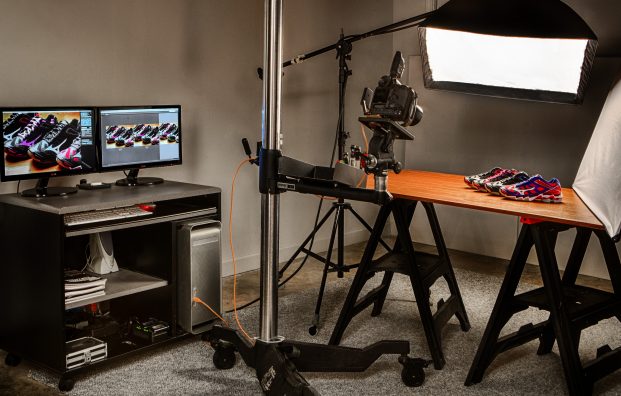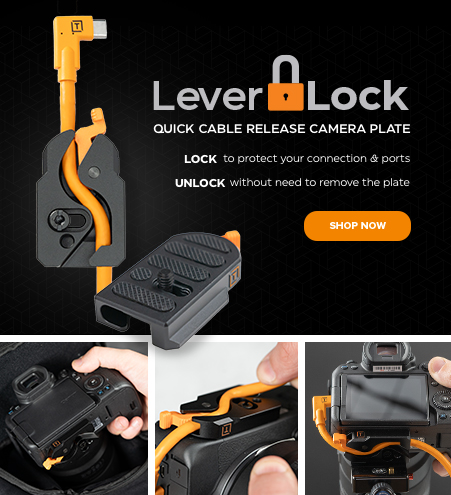
This article was written by Jim DiVitale for the Better When You Tether series of articles by professional photographers who experience the benefits of shooting tethered in various shooting environments.
 Shooting Tethered Whenever Possible
Shooting Tethered Whenever Possible

Forty years ago, when I was in the 10th grade, I knew I was going to be a commercial advertising photographer. I bought an old 8×10 view camera and went to work crafting photographic images, not just taking pictures. The artistic and precision control of large format photography was what interested me.
In 1992, when the first practical digital camera came on the market, I made the $50,000 investment and went completely digital. Starting with the first Leaf DCB three-shot camera, I taught myself how to get these new images captured, processed and outputted properly. There were no books on digital photography out yet. We made up the rules as we went along, with trial and error.

Shooting tethered was the only way we could work. We learned from the start that getting the information on the large monitors really made a difference on the quality control in the captured image. Later, when practical color management and assigned color spaces and profiles were added, we could finally see with accuracy what the finished printed piece was going to look like.
Digital photography was slowly becoming the standard as new cameras were developed that no longer needed to be tied to the computer for exposure. Of course that was great for some types of imaging making, but for me, tethered photography was the only way to completely control the capture process.

Before the computer and digital capture, I was specializing in multi-image composite imaging, working with large format multiple camera exposures and pin register masking on large transparency film. With the changes to computers, the work stayed the same, but the way I created it was completely different. Tethered photography, along with complete color management, paved the way for repeatable and predictable results every time, which keeps the clients very happy and coming back for more. For both my assignment advertising and photo illustration work, or for my personal fine art, I shoot tethered whenever possible.
I currently shoot Canon 1Ds Mark III cameras tethered to my different Mac computers using the Canon Utility Software to control captures. Images are processed in Adobe Camera Raw and assembled and retouched in Adobe Photoshop CS6. I am now also using my CamRanger wireless tethering system to shoot to my iPad and iPhone. This way I have the same control I have always had, without have the computer hardwired to the camera. It really makes a difference in the studio when working with clients. They can keep clear of the set and have all the input and control needed to create the perfect image.
Jim’s Top 5 Tips For Better Digital Photography
#1 Create a complete color managed workflow that means a having custom profile for your camera, monitor and printer all working together for predicable results.
#2 Shoot Raw format files and process them into 16 bit while adjusting them for the best dynamic range and non-destructive editing
#3 It’s all about the numbers. Shooting for good detail by the numbers is so very important. Looking at the 256 tones of the final eight-bit RGB file, white with detail should fall between 240-245. The shadow with detail point should fall between 20-25. Any thing outside of those numbers will not have detail when going to the final printing.
#4 Use Adobe Photoshop’s or Lightroom’s Photo Web Gallery for quick feedback from clients that are not there for critical decisions on the set. This way you clients can art direct remotely from anywhere.
#5 Back-up all working and final files to multiple storage destinations and 1 should be a non rewritable source like CD DVD or Blue Ray disc. Use a software like Extensis Portfolio to keep track where all the files reside.
About Jim DiVitale

Science and Medicine and has lectured on digital photography before audiences worldwide. Jim’s award winning digital photography has been featured in many publications including Professional Photographer, Photoshop User Magazine, Photo District News, Digital Imaging, After Capture Magazine. Graphis Photo, Print, Archive Magazine, Create Magazine, Creativity, and Rangefinder. His clients have included Cisco, Mizuno USA, Rubbermaid, William Carter Co, Toshiba, TEC America, Kenneth Cole, Bellsouth, BP Amoco, COX Media, Genuine Parts Company, JP Morgan Financial, and Coca-Cola USA.View Jim’s portfolio and digital imaging blog at: www.DiVitalePhotography.com


 Shooting Tethered Whenever Possible
Shooting Tethered Whenever Possible


